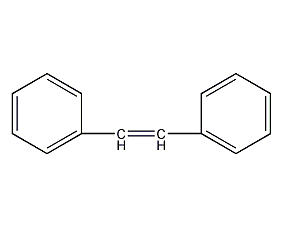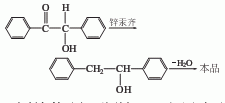
Structural formula
| Business number | 02N9 |
|---|---|
| Molecular formula | C14H12 |
| Molecular weight | 180.25 |
| label |
trans-1,2-stilbene, (E)-Stilbene, (E)-1,1′-(1,2-Ethenediyl)bisbenzene, aromatic compounds |
Numbering system
CAS number:103-30-0
MDL number:MFCD00064300
EINECS number:203-098-5
RTECS number:WJ4926500
BRN number:1616740
PubChem number:24888472
Physical property data
1. Properties: colorless needle-like crystals
2. Density (g/mL, 25℃): 0.9707
3. Relative vapor density (g/mL, air =1): Undetermined
4. Melting point (ºC): 124
5. Boiling point (ºC, normal pressure): 306.5
6. Boiling point ( ºC, 1.6KPa): 166-167
7. Refractive index (n17D): 1.6264 p>
8. Solubility parameter (J·cm-3)0.5: 19.538
9. van der Waals area (cm2·mol-1): 1.276×1010
10. van der Waals volume (cm3 ·mol-1): 108.620
11. Vapor pressure (mmHg, 20ºC): Undetermined
12. Saturated vapor pressure ( kPa, ºC): Undetermined
13. Heat of combustion (KJ/mol): Undetermined
14. Critical temperature (ºC): Undetermined
15. Critical pressure (KPa): Undetermined
16. Log value of oil-water (octanol/water) distribution coefficient: Undetermined
17. Explosion upper limit (%, V/ V): Undetermined
18. Lower explosion limit (%, V/V): Undetermined
19. Solubility: Insoluble in water, slightly soluble in ethanol, soluble in Ether and benzene. Can evaporate with water vapor
Toxicological data
Acute toxicity: Mouse oral LD50: 920mg/kg; Mouse peritoneal cavity LD50: 6500mg/kg;
Ecological data
It is extremely harmful to water and toxic to fish. Do not let the product enter the water body.
Molecular structure data
1. Molar refractive index: 63.64
2. Molar volume (cm3/mol): 172.6
3. Isotonic specific volume (90.2K ): 441.9
4. Surface tension (dyne/cm): 42.9
5. Dielectric constant: 2.85
6. Dipole moment (10-24cm3):
7. Polarizability: 25.23
Compute chemical data
1. sparseReference value for water parameter calculation (XlogP): 4.8
2, Number of hydrogen bond donors: 0
3, Number of hydrogen bond acceptors: 0
4 , Number of rotatable chemical bonds: 2
5, Number of tautomers:
6, Topological molecular polar surface area (TPSA): 0
7 , Number of heavy atoms: 14
8, Surface charge: 0
9, Complexity: 149
10, Number of isotope atoms: 0
11. Determine the number of atomic stereocenters: 0
12. Uncertain number of atomic stereocenters: 0
13. Determine the number of chemical bond stereocenters: 1
p>
14. Number of uncertain chemical bond stereocenters: 0
15. Number of covalent bond units: 1
Properties and stability
1. Avoid contact with strong oxidants.
2.Inhaling the aerosol of this product will cause weight loss, nosebleeds and leukopenia in rats. Mice were intraperitoneally injected with LD501150mg/kg; mice were intravenously injected with LD5034mg/kg. The risk of inhalation and entry of this product into the gastrointestinal tract should be eliminated. The workplace should be well ventilated and equipment should be sealed. Operators should wear protective equipment.
3. Exist in smoke.
Storage method
Store in a cool, ventilated warehouse. Keep away from fire and heat sources. should be kept away from oxidizer, do not store together. Equipped with the appropriate variety and quantity of fire equipment. The storage area should be equipped with emergency release equipment and suitable containment materials. Put it into a sturdy wooden box, wooden barrel, or plastic barrel, lined with plastic bags or kraft paper bags. The packaging should be tightly sealed, and the outside of the box should be tied tightly with iron wire and iron sheets. The net weight of each piece shall not exceed 50kg.
Synthesis method
It is obtained by dehydration of benzoin (diphenylhydroxyethylketone or benzoin, [579-44-2]) in the presence of zinc amalgam. First prepare zinc amalgam, add it to ethanol and benzoin, and then add hydrochloric acid dropwise while stirring, keeping the temperature at 15°C. After 2 hours of addition, continue stirring for another 2 hours, add cold water, then filter out the precipitate, extract with hot ethanol, cool, crystallize, and then recrystallize with ethanol to obtain the finished product.

Purpose
It is a raw material for organic synthesis and can be used to prepare diphenyl acetylene as a scintillation reagent. It is also used in the synthesis of fluorescent whitening agents and dyes.

 微信扫一扫打赏
微信扫一扫打赏

